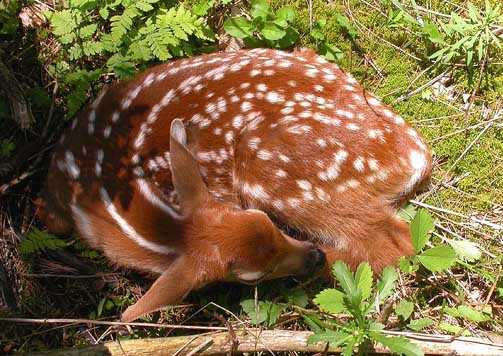
DON’T REMOVE FAWNS before checking the following:
See if the fawn is in a safe spot – (i.e., not in the middle of a road, not too close to a road or in an exposed ditch, etc. If s/he is, then the fawn can be moved about 50 to 100 feet to a safer location, preferably in the woods or high grass near the woods.
Does the fawn look healthy?
- Shiny, clean coat
- Clear eyes
- Wet nose
- No discharges
- Curled up
- Resting comfortably
If yes, the fawn’s healthy.
Understand that the Mom (doe) will give birth and leave the fawn. She can leave up to about 12 hours, and then come back to nurse when the fawn bleats (calls out). Bleating sounds like a baby goat (kid). When the mom hears that, she will go to the fawn within about 20-40 minutes. Just stay back and watch with binoculars. Mom is normally within a 500’ radius of the fawn.
SHE IS NOT ABANDONING HER BABY. She does not want to bring attention to the fawn by being with him/her, and she needs to feed herself to generate more milk to give to the fawn. Please give Mom and the fawn space. Stay back and watch with binoculars. You can continue to check on the fawn, while keeping your distance. Mom will only be there when she has to nurse, and she comes usually when it’s dark or almost dark (dawn or dusk). She nurses quickly and then leaves again.
The fawn may leave the area that day or in several days. At 2-3 weeks old, the fawn will follow Mom,
To see if the fawn is hydrated, you can pull the skin gently and it should snap right back, or you can observe or feel his belly to see if it feels full.
If, on the other hand, you determine that there is a problem:
- The fawn on his side or his legs are stretched out
- You see a dead deer on the road (check to see if the deer is a nursing female), and you believe the deer could be the mother of the fawn,
- If you see a fawn walking around calling out for more than about 40 minutes,
- Covered with insects
Those are not good signs and could indicate that something has happened to the Mom.
If you have already removed a healthy fawn, you can put the fawn back. We’ve had reports that the mother has returned even after a few days, but be sure to keep an eye on the fawn because the Mom’s milk may have dried up by then. So put him back if you can continue to check on him.
Fawns should only be given goat's milk or a fawn replacement milk. Do not give cow's milk.
Wildlife Watch maintains updated lists of wildlife rehabilitators across the country. If you feel that the fawn is in trouble, please call us for a wildlife rehabilitator in your area. Our wildlife help and rehabilitator referral number is 1-877-WILD-HELP( 877-945-3435 ).

